Terminology / FAQ
What is rowing?
It is the physical act of moving a boat across water using an oar in an oarlock as a lever. An oar “blade” is placed in the water with oar “shaft” resting in the “oarlock” (and against the “pin”) midway down the “shaft”. With the “pin” acting as a fulcrum, the oar is pulled by the oar “handle”, thereby using the mechanical advantage of a lever and fulcrum system to move the boat. Rowing is NOT paddling; paddling does not employ the efficiency of mechanical advantage.
What do I wear to rowing?
Summer
A simple pair of short and t-shirt work the best. I usually tell most people whatever you would go to the gym and work out in is usually acceptable down at the boathouse. Always bring a pair of socks to wear in the boat as your feet will be in shoes that are already existing in the boat. No baggy clothing or bare-midriff. As you progress in the sport you will probably want to purchase some spandex and a tighter fitting shirt so as to limit restriction and ease of movement.
Fall & Spring
As it is much colder the main word here is layers. The weather is always unpredictable and you need to be ready for everything. Attempt to keep everything as tight fitting as possible with no baggy clothing that can potentially get stuck in the tracks while rowing. If you are dressed appropriately you will probably take a layer or two off in the boat as your body temperature begins to rise while working-out. Any type of long-sleeve, and full leg spandex is always helpful to keep a minimum amount of skin exposed.
A simple pair of short and t-shirt work the best. I usually tell most people whatever you would go to the gym and work out in is usually acceptable down at the boathouse. Always bring a pair of socks to wear in the boat as your feet will be in shoes that are already existing in the boat. No baggy clothing or bare-midriff. As you progress in the sport you will probably want to purchase some spandex and a tighter fitting shirt so as to limit restriction and ease of movement.
Fall & Spring
As it is much colder the main word here is layers. The weather is always unpredictable and you need to be ready for everything. Attempt to keep everything as tight fitting as possible with no baggy clothing that can potentially get stuck in the tracks while rowing. If you are dressed appropriately you will probably take a layer or two off in the boat as your body temperature begins to rise while working-out. Any type of long-sleeve, and full leg spandex is always helpful to keep a minimum amount of skin exposed.
What’s the difference between sweep & scull rowing?
Sculling
Athletes with two oars – one in each hand – are scullers.
There are three sculling events: the single – 1x (one person), the double – 2x (two) and the quad – 4x (four).
Sweep
Athletes with only one oar are sweep rowers. Sweep boats may or may not carry a coxswain (pronounced cox-n) to steer and be the on-the-water coach. In boats without coxswains, one of the rowers steers by moving the rudder with his or her foot.
Sweep rowers come in pairs with a coxswain (2+) and pairs without (2-), fours with a coxswain (4+) and fours without (4-) and the eight (8+), which always carries a coxswain. The eight is the fastest boat on the water. A world-level men’s eight is capable of moving almost 14 miles per hour.
The pairs and fours with coxswain are sometimes the hardest to recognize because of where the coxswain is sitting. Although the coxswain is almost always facing the rowers in an eight, in pairs and fours the coxswain may be facing the rowers in the stern or looking down the course, lying down in the bow, where he or she is difficult to see.
Athletes with two oars – one in each hand – are scullers.
There are three sculling events: the single – 1x (one person), the double – 2x (two) and the quad – 4x (four).
Sweep
Athletes with only one oar are sweep rowers. Sweep boats may or may not carry a coxswain (pronounced cox-n) to steer and be the on-the-water coach. In boats without coxswains, one of the rowers steers by moving the rudder with his or her foot.
Sweep rowers come in pairs with a coxswain (2+) and pairs without (2-), fours with a coxswain (4+) and fours without (4-) and the eight (8+), which always carries a coxswain. The eight is the fastest boat on the water. A world-level men’s eight is capable of moving almost 14 miles per hour.
The pairs and fours with coxswain are sometimes the hardest to recognize because of where the coxswain is sitting. Although the coxswain is almost always facing the rowers in an eight, in pairs and fours the coxswain may be facing the rowers in the stern or looking down the course, lying down in the bow, where he or she is difficult to see.
How do I know where to sit in a boat?
Identifying positions in the boat
Athletes are identified by their seat in the boat. The athlete in bow is seat No. 1. That’s the person who crosses the finish line first (which makes it easy to remember – first across the line is No. 1 seat). The person in front of the bow is No. 2, then No. 3, No. 4, No. 5, No. 6, No. 7 and No. 8, a.k.a. the stroke. The stroke of the boat must be a strong rower with excellent technique, since the stroke sets the rhythm and number of strokes per minute the rest of the crew must follow.
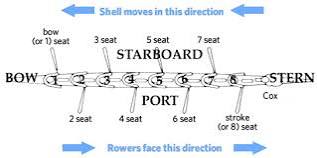
Athletes are identified by their seat in the boat. The athlete in bow is seat No. 1. That’s the person who crosses the finish line first (which makes it easy to remember – first across the line is No. 1 seat). The person in front of the bow is No. 2, then No. 3, No. 4, No. 5, No. 6, No. 7 and No. 8, a.k.a. the stroke. The stroke of the boat must be a strong rower with excellent technique, since the stroke sets the rhythm and number of strokes per minute the rest of the crew must follow.

What’s the difference between a Sprint and Head race?
The Sprint Race
National, collegiate, worlds, and Olympic sprint competitions are 2,000 meters, or approximately 1.25 miles. The race course is divided into 6-8 lanes and each 500-meter section is marked with buoys. Masters races are 1,000 meters. Often, juniors races are 1,500 meters. The race begins with all boats aligned at the start in the lanes they’ve been assigned. Individuals in each lane hold the stern of each boat steady while an official, known as the aligner, ensures that each boat is even with the others and squarely facing the course. Each crew is allowed one false start; two means disqualification. If within the first 100 meters there is legitimate equipment breakage (e.g., an oar snaps in two), the race will be stopped and restarted with repaired equipment. The stroke rate (the number of rowing strokes per minute that a crew is taking ) is high at the start – maybe 45 to even 50 for an eight; 38 to 42 for a single scull. Then, the crew will “settle” into the body of the race and drop the rating back – 38 to 40 for an eight; 32-36 for a single. The coach and the way the race is going determine when the crew will sprint but finishing stroke rates of 46+ in the last 200 meters aren’t unheard of. However, higher stroke rates are not always indicative of speed. A strong, technically talented crew may be able to cover more water faster than a less-capable crew rowing a high stroke rate. Unlike canoe/kayak competitions, rowers are allowed to leave their lanes without penalty, so long as they do not interfere with anyone else’s opportunity to win. An official follows the crews to ensure safety and fairness. Despite the exhaustion of the race, the crew will row for five to 10 minutes afterwards in order to cool down. In rowing, the medals ceremonies include the shells. The three medal-winning crews row to the awards dock, climb out of their shells and receive their medals before rowing away.
The Head Race
Head races, which are generally held in the fall, about 2.5-3 miles long and the boats are started in their respective divisions separately at 10 second intervals. They are usually conducted on a river with an assortment of bridges and turns that can make passing quite interesting. The winner is the crew that had the shortest elapsed time between the start and finish lines, with any additional time included for penalties
National, collegiate, worlds, and Olympic sprint competitions are 2,000 meters, or approximately 1.25 miles. The race course is divided into 6-8 lanes and each 500-meter section is marked with buoys. Masters races are 1,000 meters. Often, juniors races are 1,500 meters. The race begins with all boats aligned at the start in the lanes they’ve been assigned. Individuals in each lane hold the stern of each boat steady while an official, known as the aligner, ensures that each boat is even with the others and squarely facing the course. Each crew is allowed one false start; two means disqualification. If within the first 100 meters there is legitimate equipment breakage (e.g., an oar snaps in two), the race will be stopped and restarted with repaired equipment. The stroke rate (the number of rowing strokes per minute that a crew is taking ) is high at the start – maybe 45 to even 50 for an eight; 38 to 42 for a single scull. Then, the crew will “settle” into the body of the race and drop the rating back – 38 to 40 for an eight; 32-36 for a single. The coach and the way the race is going determine when the crew will sprint but finishing stroke rates of 46+ in the last 200 meters aren’t unheard of. However, higher stroke rates are not always indicative of speed. A strong, technically talented crew may be able to cover more water faster than a less-capable crew rowing a high stroke rate. Unlike canoe/kayak competitions, rowers are allowed to leave their lanes without penalty, so long as they do not interfere with anyone else’s opportunity to win. An official follows the crews to ensure safety and fairness. Despite the exhaustion of the race, the crew will row for five to 10 minutes afterwards in order to cool down. In rowing, the medals ceremonies include the shells. The three medal-winning crews row to the awards dock, climb out of their shells and receive their medals before rowing away.
The Head Race
Head races, which are generally held in the fall, about 2.5-3 miles long and the boats are started in their respective divisions separately at 10 second intervals. They are usually conducted on a river with an assortment of bridges and turns that can make passing quite interesting. The winner is the crew that had the shortest elapsed time between the start and finish lines, with any additional time included for penalties
How can I spot good rowing technique on the water?
The crew that’s making it look easy is most likely the one doing the best job. While you’re watching, look for continuous, fluid motion of the rowers. The rowing motion shouldn’t have a discernible end or beginning.
Synchronization. Rowers strive for perfect synchronization in the boat. Clean catches of the oarblade. If you see a lot of splash, the oarblades aren’t entering the water correctly. The catch should happen at the end of the recovery, when the hands are as far ahead of the rower as possible. Rowers who uncoil before they drop the oarblades are sacrificing speed and not getting a complete drive.
Synchronization. Rowers strive for perfect synchronization in the boat. Clean catches of the oarblade. If you see a lot of splash, the oarblades aren’t entering the water correctly. The catch should happen at the end of the recovery, when the hands are as far ahead of the rower as possible. Rowers who uncoil before they drop the oarblades are sacrificing speed and not getting a complete drive.
Any tips for a first-time race spectator?
Race times can vary considerably depending upon the course and weather conditions. Tailwinds will improve times, while headwinds and crosswinds will hamper them.
If a crew “catches a crab,” it means the oarblade has entered the water at an angle instead of perpendicularly. The oarblade gets caught under the surface and will slow or even stop a shell.
A “Power 10” is a call by the coxswain for 10 of the crew’s best, most powerful strokes. Good coxswains read the course to know how many strokes remain for their crew to count down to the finish.
Crews are identified by their oarblade design. The USA blades are red on top and blue on the bottom, with a white triangle at the tip. It doesn’t matter whether you win an Olympic medal or don’t make the finals – each crew still carries their boat back to the rack. Coxswains from first-place boats worldwide are thrown into the water by their crews.
Coxswains don’t now and probably never did yell “stroke! stroke!” Similar to a jockey, their job is to implement the coach’s strategy during the race, in addition to steering and letting the rowers know where they stand in the race and what they need to do to win.
If a crew “catches a crab,” it means the oarblade has entered the water at an angle instead of perpendicularly. The oarblade gets caught under the surface and will slow or even stop a shell.
A “Power 10” is a call by the coxswain for 10 of the crew’s best, most powerful strokes. Good coxswains read the course to know how many strokes remain for their crew to count down to the finish.
Crews are identified by their oarblade design. The USA blades are red on top and blue on the bottom, with a white triangle at the tip. It doesn’t matter whether you win an Olympic medal or don’t make the finals – each crew still carries their boat back to the rack. Coxswains from first-place boats worldwide are thrown into the water by their crews.
Coxswains don’t now and probably never did yell “stroke! stroke!” Similar to a jockey, their job is to implement the coach’s strategy during the race, in addition to steering and letting the rowers know where they stand in the race and what they need to do to win.
BOW PAIR
In an 8+ or 4+ boat, the bow pair is the more technical of the rowers. They set up the balance of the boat and have the most influence on the line the boat steers.
CLUB
A rowing program not affiliated with any one school, but rather a region, town, or city.
COXSWAIN or COX
Person who steers the shell and is the on-the-water coach for the crew. Depending on the boat type, the coxswain will sit in the bow or stern of the boat.




CRAB
A crab occurs when an oar remains in the water at the finish of a stroke and is not removed. Such an occurrence de-stabilizes and often stops the run of a boat. Thought occasionally the mistake of one rower, crabs are most often the result of poor rowing by a crew. See also “run”.
CREW
A boat of rowers, and possibly a coxswain. Also, “crew” can refer to an entire rowing program. Though often said, no one “does crew”. That is like someone saying, “I do baseball team.” Appropriate use of the term would be: “I am on the crew.” Rowers do not “play crew” or “row crew.”
ERGOMETER
Rowers call it an “erg.” It’s a rowing machine that closely approximates the actual rowing motion. The rowers’ choice is the Concept II, which utilizes a flywheel and a digital readout so that the rower can measure his or her “strokes per minute” and the distance covered.
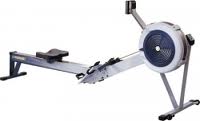

FEATHER
Turning the handle of the oars so that the blade is parallel (flat) to the water.
FISA
Short for Federation Internationale des Societes d’Aviron. The international governing body for the sport of rowing in the world, established in 1892.
JUNIOR
A rower 18 years of age or younger.
NOVICE
A new rower who has been rowing less than one year. A novice can be any age or grade.
PORT
Left side of the boat, while facing forward, in the direction of the movement.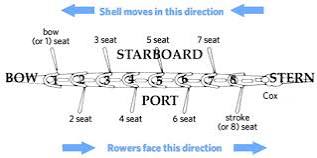

PR
“PR” stands for “personal record”. Athletes also use “PB” for “personal best”. PR refers to one’s best time on an erg test of 2000 or 6000 meters.
PUDDLE
The mass of water being moved by an oar, the size of the puddle indicates the amount of energy it contains – a small and slowly swirling puddle will make the boat move, a big a fast swirling puddle has a lot of energy and will make the boat move much faster.
REGATTA
Regattas feature side by side racing, where all the boats start at the same time from a stationary position and the winner is the boat that crosses the finish line first. The number of boats varies between two (which is sometimes referred to as a ‘dual race’) to six, but any number of boats can start together if the course is wide enough. Standard length for races is 2000 m long. Race distance varies from ‘dashes’ or ‘sprints,’ which may be 500 m long. Multi-boat competitions are usually organized in a series of rounds, with the fastest boats in each heat qualifying for the next round. The losing boats from each heat may be given a second chance to qualify through a repechage
REPECHAGE
The second-chance race which ensures that everyone has two chances to advance from preliminary races since there is no seeding in the heats.
RUN
The run is the distance the shell moves during one stroke. You can figure it by looking for the distance between the puddles made by the same oar.
SCHOLASTIC
This term refers to rowing teams whose athletes come from one high school (public or private).
SQUARE
A blade in perpendicular position to the surface of the water. A blade must be “square” in the water for the oar to leverage and move the boat. A blade that is “feathered” is good out of the water, but useless in leveraging a boat. See also “feather.”
STARBOARD
Right side of the boat, while facing forward, in the direction of movement.
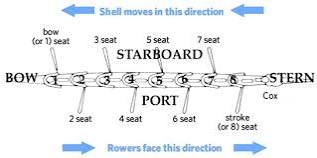

STERN PAIR
In an 8+ boat, the stern pair are responsible for setting the stroke rate and rhythm for the rest of the boat to follow.
STROKE
The rower who sits closest to the stern. The stroke sets the rhythm for the boat; others behind them must follow their cadence.
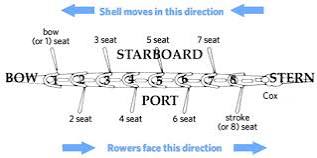

STROKECOACH
A small electronic display that rowers attach in the boat to show the important race information like stroke rate and elapsed time.
SWING
The hard-to-define feeling when near-perfect synchronization of motion occurs in the shell, enhancing the performance and speed.
USROWING
The governing body of rowing in the United States.
BLADE
The end of an oar opposite the handle. The blade is the broad, flat part of an oar that helps the oar lock into the water and leverage the boat.
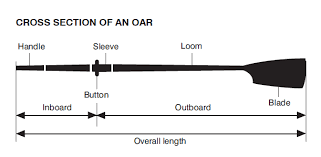



BOW
The forward section of the boat. The first part of the boat to cross the finish line. The person in the seat closest to the bow (seat “one”), who crosses the finish line first.
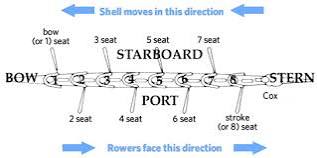

BOWBALL
The rubber ball attached to the very tip of a boat to provide protection for both the boat and anything it may bump.
BUTTON or COLLAR
A wide collar on the oar that keeps it from slipping through the oarlock. Usually referred to simply as the collar.


DECK
The part of the shell at the bow and stern that is covered with fiberglass cloth or a thin plastic. Also, the part of a boat between the gunnels on which rowers sit.
FIN or SKAG
The triangular shaped piece that extends down from the “hull” to help in the steering and stabilization of a boat.
FOOTBOARD or FOOTPLATE
The platform against which rowers push with their feet and legs when leveraging an oar to move the boat.
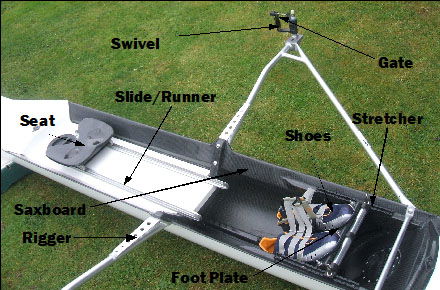

FOOT STRETCHER
The foot stretcher holds the footboard, which hold the shoes. Its important to adjust the foot stretchers to your liking (to fit your height), in every boat you sit in. In the photo it is labelled stretcher.
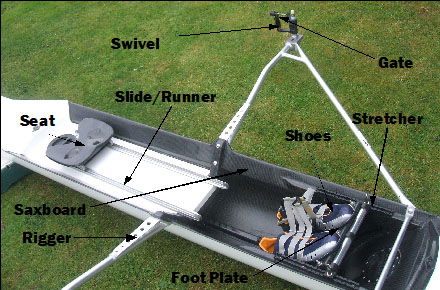

GATE
The bar across the oarlock that keeps the oar in place.


GUNNEL
The side of a boat that is out of water. The sides of a boat that are in the water is the “hull”
HANDLE
The end of an oar, by which a rower grips and manipulates the shaft and blade. In this photo, the handle is the lighter-colored section that the person has their hands on.
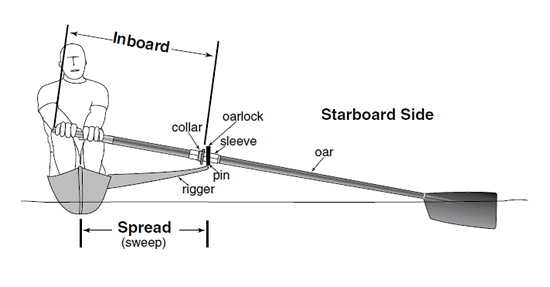



HULL
The sides (and bottom) of a boat in the water. The gunnel, or gunnels, are the sides of the boat out of the water.
OAR
Used to drive the boat forward: rowers do NOT use paddles. Paddles are for people who have not figured the mechanical advantage of using a lever, and also one’s entire body, to move a boat. In the photo, the entire piece of equipment (from where the hands lay, to the end of the blade) cis what the oar is comprised of.
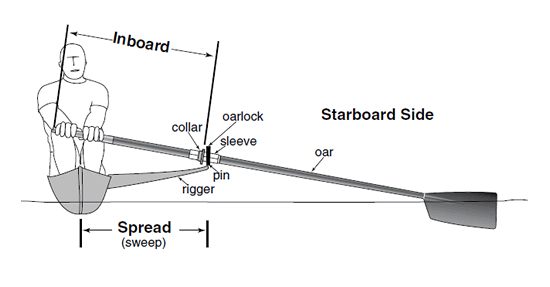

OARLOCK
An oarlock is attached to a pin. The oarlock holds the oar against the pin so that together they can act as a lever and fulcrum.
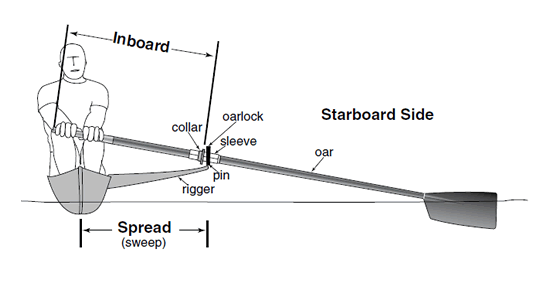

PIN
The pin is held in place by the rigger. The pin is the fulcrum used, with an oar as a lever, to move a boat.


RIGGER
The triangular shaped metal device that is bolted onto the side of the boat and holds the pin, oarlock and oars.




RUDDER
The rudder steers a boat. It is most often directly adjacent to the fin (or “skag”). The rudder is controlled by the cox, if present, or by one of the crew with a the rudder cable is attached to the toe of one of their shoes which can pivot about the ball of the foot, moving the cable left or right.
SEAT
The moveable platform on the deck inside a boat on which rowers sit. The moving nature of the seat allows rowers to use their legs as well as their back and arms.


SHAFT or LOOM
A long, cylindrical part of the oar.
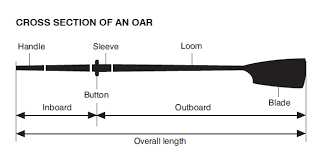

SHELL
Can be used interchangeably with “boat.”
SLIDE or RUNNER
The set of runners for the wheels of each seat in the boat.


STERN
The rear of the boat; the direction the rowers are facing.
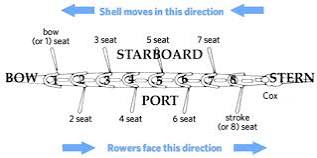

BOW COXED BOAT
A shell in which the coxswain is near the bow instead of the stern. It’s hard to see the coxswain in this type of boat, because only his or her head is visible. Having the coxswain virtually lying down in the bow reduces wind resistance, and the weight distribution is better.
DOUBLE
A two-rower boat in which each rower uses two oars.
EIGHT
An eight-oared shell in which each of the eight rowers uses one oar. Also, the eighth seat from the bow, or “stroke” seat. The fastest of all commonly rowed boats. Symbolized as: 8+ (the “+” indicates a cox’n in the boat.)
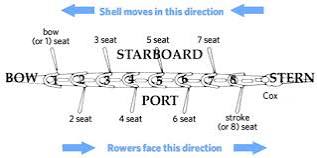

FIRST VARSITY
The top fastest combination of rowers and a coxswain in a four-oared or eight-oared boat at the high school or collegiate rowing level
FOUR
A four-oared shell in which each of the four rowers uses one oar. Also, the fourth seat from the bow. Symbolized as: 4+ (with a cox’n) or 4- (without a cox’n).
GERMAN RIGGED BOAT
A different way of setting up which side of the boat the oars are on in a sweep boat. Instead of alternating from side to side all the way down, in a German rigged boat, two consecutive rowers have oars on the same side.
LIGHTWEIGHT
Refers to the rowers, not the boats; there is a maximum weight for each rower in a lightweight event as well as a boat average.
SINGLE
A boat rowed by one rower with two oars. The slowest of all boats commonly rowed. Symbolized by: 1x
STRAIGHT
Refers to a shell without a coxswain i.e. a straight four or straight pair.